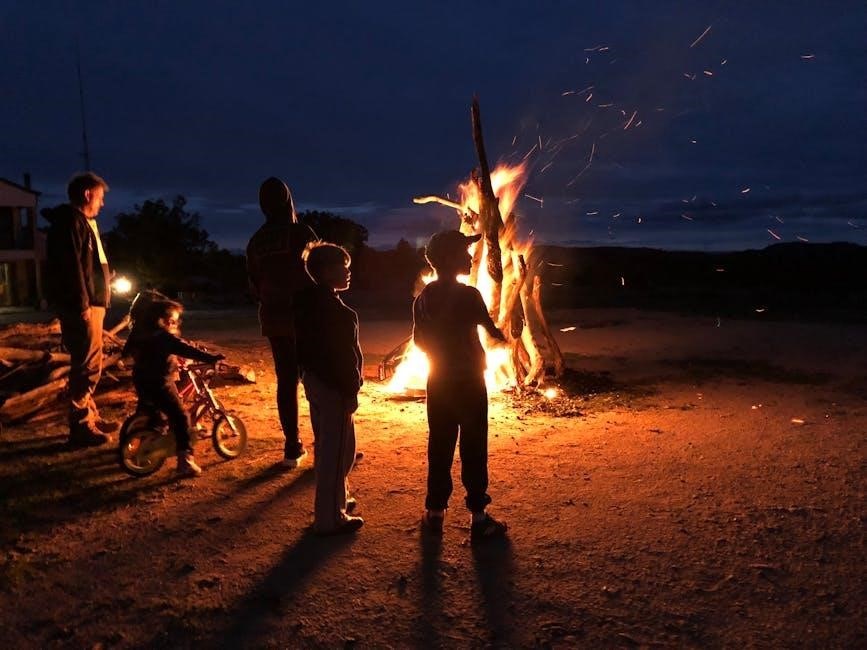
glow a family guide to the night sky
Welcome to the enchanting world of the night sky! Glow: A Family Guide to the Night Sky invites you to explore stars, planets, and celestial wonders together, fostering curiosity and family bonding through stargazing adventures.
Welcome to the Wonders of the Night Sky
Step into the magical realm of the night sky, where stars, planets, and celestial wonders await discovery. Glow: A Family Guide to the Night Sky is your perfect companion for stargazing adventures, offering a vibrant journey through the cosmos. With stunning illustrations and engaging content, this guide makes astronomy accessible and fun for all ages. Learn to identify constellations, understand the phases of the moon, and observe planets visible to the naked eye. Designed for families, it sparks curiosity and fosters a deeper connection to the universe, encouraging shared moments of wonder and discovery under the stars.
Why Explore the Night Sky as a Family?
Exploring the night sky as a family is a timeless and enriching experience that fosters curiosity, wonder, and bonding. It introduces children to the magic of science and the universe, sparking lifelong interests in astronomy. Together, you can discover constellations, observe planets, and learn about celestial events. This shared journey creates lasting memories and encourages a deeper appreciation for the natural world. Glow: A Family Guide to the Night Sky makes it easy and fun, offering a way to connect generations and inspire a sense of awe in the mysteries of the cosmos;

How to Use This Guide Effectively
Maximize your stargazing experience with Glow: A Family Guide to the Night Sky by following its structured approach. Begin with the introductory sections to build foundational knowledge. Use the seasonal constellation charts and moon phase guides to plan your observations. Engage in family activities and journaling to deepen understanding and create lasting memories. Refer to the recommended resources for further exploration. Adapt the guide to your family’s pace, ensuring a fun and educational journey through the cosmos together.

Preparing for Stargazing

Start your stargazing journey by gathering essential tools like binoculars, star charts, and red-light flashlights. Choose dark locations, dress warmly, and time your sessions for clear skies.
Essential Tools for Family Stargazing
Begin your stargazing adventures with a few simple yet essential tools. Binoculars are perfect for a closer look at the Moon and bright objects. A star chart or planisphere helps identify constellations based on the season and your location. Red-light flashlights preserve your night vision, while a telescope offers deeper exploration of celestial wonders. Don’t forget blankets, snacks, and warm clothing for comfort. For younger learners, a glow-in-the-dark star map can spark curiosity. These tools will enhance your family’s stargazing experience, making it both educational and enjoyable for all ages.
Choosing the Best Locations for Stargazing
Finding the perfect spot for stargazing is key to a magical experience. Seek locations far from city lights to avoid light pollution, as darker skies reveal more stars. National parks, remote rural areas, or beaches often offer ideal conditions. Check for Dark Sky Sanctuaries or areas with minimal artificial light. Use online maps or apps like Glow: A Family Guide to the Night Sky to locate the best spots. Plan ahead to ensure clear weather and a new moon for optimal stargazing. Remember, the darker the location, the brighter the stars will appear!
Timing Your Stargazing Sessions
Timing is essential for a memorable stargazing experience; Aim for clear, cloudless nights and avoid the full moon, as its brightness can obscure fainter stars. The best viewing times are typically between 9 PM and 1 AM, when the sky is darkest. Seasonal constellations appear at specific times of the year, so plan ahead to catch your favorites. Use apps or calendars to track celestial events like meteor showers or planetary alignments. Check the weather forecast beforehand and ensure the moon is in a phase that won’t overpower the stars. Proper timing enhances the magic of your family stargazing adventures!
Creating a Comfortable Stargazing Experience
For a cozy stargazing session, bring blankets, chairs, and warm clothing to keep everyone comfortable. Snacks and water are essentials to keep energy levels up. Allow time for your eyes to fully adjust to the dark—about 20 minutes—for the best views. Ensure the area is safe for children to move around and free from tripping hazards. Red flashlights can preserve night vision while navigating. Make it fun by sharing stories or playing soft music to enhance the ambiance. These small touches create lasting memories and make stargazing a delightful family adventure!
Understanding the Night Sky
Explore the solar system, stars, constellations, and moon phases. Learn about planets visible to the naked eye and celestial movements, sparking curiosity and wonder for all ages.
The Basics of the Solar System
Discover the solar system’s fascinating structure, centered around the Sun. Learn about the eight planets, starting from Mercury to Neptune, and their unique characteristics. Explore how Earth is our home, while Venus shines brightest, and Mars captivates with its reddish hue. Understand the roles of the Moon and Sun in our daily lives, and how planets like Jupiter and Saturn stun with their size and rings. This section provides a foundation for understanding celestial bodies and their movements, sparking curiosity and wonder for families to explore together under the night sky.
Identifying Stars and Constellations
Discover the magic of identifying stars and constellations! Start by locating the North Star, a constant guide in the night sky. Learn to recognize seasonal patterns like Orion in winter or Ursa Major year-round. Use apps or star charts to help spot these celestial shapes. Teach children to connect the dots between stars, bringing myths and stories to life. Observing constellations fosters a deeper connection to astronomy and creates lasting family memories. Make stargazing fun and educational by exploring the night sky together, one constellation at a time.
The Moon: Phases and Observations
The Moon, Earth’s closest celestial companion, captivates us with its ever-changing phases. From the crescent’s subtle glow to the full moon’s brilliant light, each phase offers a unique opportunity for observation. Learn to identify the gibbous, quarter, and new moon stages, and witness how the Moon’s brightness transforms the night sky. With binoculars or the naked eye, families can explore craters and marvel at lunar eclipses. Tracking the Moon’s phases in a journal fosters curiosity and appreciation for its rhythmic dance, connecting us to Earth’s tides and natural cycles. Together, discover the timeless beauty of our lunar neighbor.
Planets Visible to the Naked Eye
Discover the planets visible to the naked eye, such as Mercury, Venus, Mars, and Jupiter. Venus, often the brightest, shines in the evening or morning sky. While others like Saturn and Uranus require telescopes, these four are easily observable. Learn optimal viewing times and how to distinguish them from stars. Use binoculars for a closer look. Exploring these celestial neighbors fosters curiosity and connects families to the solar system’s wonders, making stargazing an unforgettable experience.
Understanding Celestial Movements
Understanding celestial movements helps us predict patterns in the night sky. The Earth’s rotation creates day and night, while its orbit around the Sun determines seasons. The Moon’s phases result from its monthly journey around Earth. Planets like Venus and Mars move across the sky at varying speeds, with some appearing closer or farther depending on their orbits. Recognizing these movements allows families to track constellations and planets more effectively, fostering a deeper appreciation for the dynamic nature of the universe and its rhythmic beauty.

Exploring Constellations
Discover the captivating world of constellations, where ancient stories meet celestial patterns. From Orion to Cassiopeia, these star groups guide us through the night sky’s endless wonders.
Recognizing Seasonal Constellations
Seasonal constellations offer a dynamic way to explore the night sky, as their visibility changes throughout the year. In winter, constellations like Orion and Taurus dominate, while spring brings Leo and Virgo. Summer showcases Scorpius and Cygnus, and autumn highlights Pegasus and Cassiopeia. Each constellation has unique patterns and stories, making them easier to identify. Families can learn to track these seasonal shifts, using stories and shapes to guide their observations. This ever-changing celestial display encourages regular stargazing and fosters a deeper connection to the universe’s rhythms.
The Stories Behind Major Constellations
Major constellations are brought to life by ancient myths and legends, offering a rich cultural and historical context for stargazing. Orion, the hunter, and Scorpius, his eternal rival, recount a timeless tale of pursuit and balance. Cassiopeia, the queen, reminds us of vanity and humility, while the Magellanic Clouds whisper of distant galaxies. These stories, passed down through generations, add depth and meaning to the night sky, transforming stars into characters in a celestial drama. Sharing these tales with your family makes stargazing a journey of discovery, blending science with storytelling.
How to Locate the North Star
To find the North Star (Polaris), start by identifying the Big Dipper constellation. Look for its “bowl” and follow the two stars at the end of the bowl, known as the “pointer stars.” Draw an imaginary line through these stars and continue until you reach a bright, steady star—this is Polaris. For an extra tip, locate the Little Dipper, as Polaris marks the end of its “handle.” Finding the North Star is a timeless skill that aids in navigation and enhances your stargazing experience. Practice makes it easier, so give it a try!
Using Constellations for Navigation
Constellations have long been humanity’s guide under the stars, helping sailors, travelers, and explorers navigate the vast unknown. For families, learning to use constellations can be both educational and fun! Start by identifying the Big Dipper and use its “pointer stars” to locate the North Star, a reliable guide for determining direction. Similarly, the constellation Orion can help you find south in the winter sky. With practice, constellations become like old friends, offering a sense of orientation and connection to history. Encourage your family to explore and learn together—soon, you’ll be navigating the night sky like pros!

Celestial Events
Celestial events like meteor showers, eclipses, and planetary alignments captivate stargazers. Glow guides families to witness these breathtaking phenomena, fostering a deeper appreciation for the universe’s natural wonders together.
Understanding Eclipses
Eclipses occur when one celestial body blocks the light of another, creating a rare and awe-inspiring event. Solar eclipses happen when the Moon passes between Earth and the Sun, while lunar eclipses occur when Earth blocks sunlight from reaching the Moon. These events are fleeting and require precise alignments, making them special moments for observation. Eclipses can be total, partial, or annular, each offering a unique view. They inspire curiosity and wonder, connecting us to the universe’s rhythms. Observing eclipses safely is crucial, especially for solar ones, to protect your eyes while enjoying these cosmic spectacles.
Observing Meteor Showers
Meteor showers are spectacular displays of shooting stars, occurring when Earth passes through trails of comet or asteroid debris. To observe them, find a dark location with minimal light pollution. Dress warmly and allow your eyes to adjust to the dark for at least 20 minutes. Lie down or use a comfortable chair for optimal viewing. Peak showers like the Perseid meteor shower offer stunning displays. Be patient, as meteors can appear sporadically. This magical experience fosters a sense of wonder and connection to the universe, making it a memorable family activity to cherish together.
Comets and Their Significance
Comets are ancient remnants of the solar system’s formation, offering glimpses into its early composition. These icy bodies, often called “dirty snowballs,” release gas and dust as they approach the Sun, creating their iconic glowing tails. Comets are rare and fleeting, making their appearances special events. Historically, they’ve inspired scientific curiosity and cultural fascination, often seen as omens or celestial messengers. Observing a comet with your family can spark wonder and curiosity about the universe’s mysteries. Their unpredictable orbits make each sighting unique, providing a rare opportunity to witness a piece of cosmic history in motion.
Shooting Stars and Wishes
Shooting stars, or meteors, captivate families with their fleeting beauty. These streaks of light occur when tiny meteoroids enter Earth’s atmosphere, burning up and creating mesmerizing trails. Meteor showers, like the Perseids or Geminids, are peak times for viewing. Many cultures associate shooting stars with good luck, inspiring the timeless tradition of making wishes. Observing them together fosters a sense of wonder and connection to the cosmos. Whether during a backyard stargazing session or a camping trip, shooting stars offer magical moments for families to cherish and spark curiosity about the universe’s endless marvels.
Involve Your Family
Engage your family in stargazing adventures, fostering curiosity and shared wonder. Together, explore the night sky, creating lasting memories and a lifelong appreciation for astronomy.
Engaging Children in Stargazing

Spark curiosity in young minds by making stargazing fun and interactive. Use storytelling to introduce constellations, creating a magical experience. Encourage children to ask questions and share observations, fostering a sense of wonder and discovery. Simple tools like star charts or apps can help them identify celestial objects. Make it a routine family activity, where learning and bonding go hand in hand under the night sky.
Family Activities for Astronomy Enthusiasts
Foster a love for astronomy with engaging family activities. Create a backyard campout to observe constellations together, using star charts and apps for guidance. Plan a trip to a dark-sky sanctuary for better stargazing and learn about celestial events like meteor showers. Involve kids in setting up a telescope or binoculars, teaching them how to use these tools effectively. Discuss the science behind eclipses, planets, and the Moon’s phases, making the experience educational and enjoyable for all ages.
Creating a Family Astronomy Journal
A family astronomy journal is a wonderful way to document your stargazing adventures and track progress. Encourage everyone to record observations, note celestial events, and sketch the constellations they see. Include dates, times, and weather conditions for each entry. This journal becomes a cherished keepsake, showing how your family’s interest in astronomy evolves over time. It also sparks conversations and reflection, helping to deepen your understanding of the night sky together. Make it a routine activity to ensure consistent learning and enjoyment for all ages.
Hosting a Backyard Stargazing Party
Hosting a backyard stargazing party is a fun way to share the magic of the night sky with friends and family; Start by inviting guests and setting up a comfortable viewing area with blankets, chairs, and telescopes. Provide snacks and drinks to keep everyone energized throughout the night. Include activities like constellation scavenger hunts or storytelling about celestial myths. Encourage guests to bring their own binoculars or journals to document their observations. This event fosters a sense of community while inspiring curiosity about the universe, making it a memorable experience for all ages.
Safety and Best Practices
Ensure a safe stargazing experience by using red flashlights to protect night vision and handling telescopes with care. Always supervise children and avoid pointing devices near eyes to prevent damage.

Safety Tips for Nighttime Observations
Ensure a safe and enjoyable stargazing experience with these essential tips. Use red flashlights to preserve night vision and avoid white light exposure. Supervise children during observations and teach them to handle telescopes or binoculars gently. Never point optical devices near eyes or at bright objects like the sun. Stay hydrated, dress warmly, and bring blankets for comfort. Be aware of your surroundings to prevent accidents. Use tripod stands securely and avoid overreaching. Always prioritize eye safety and follow proper telescope maintenance. By following these guidelines, you can create a secure environment for family stargazing adventures.
Protecting Your Eyes During Stargazing
Protecting your eyes is crucial for safe and enjoyable stargazing. Use red flashlights to preserve night vision, as white light disrupts darkness adaptation. Avoid looking directly at the sun or bright celestial objects like Venus without proper solar filters. Never use binoculars or telescopes without ensuring they are safe for daytime or solar viewing. Supervise children to prevent accidental misuse of optical tools. Regularly give your eyes breaks to reduce strain. By prioritizing eye safety, you can enjoy the night sky while safeguarding your vision for future stargazing adventures.
Respecting Dark Sky Sanctuaries
Dark sky sanctuaries are sacred sites where minimal light pollution allows for breathtaking stargazing. To respect these areas, minimize artificial light use, keep noise levels low, and avoid littering. Follow posted rules and stay on designated paths to protect sensitive ecosystems. Educate your family about the importance of preserving these natural treasures. By honoring dark sky sanctuaries, you help ensure future generations can enjoy the night sky in its purest form, fostering a deeper connection to the universe and its wonders.
Reducing Light Pollution
Light pollution hinders stargazing by masking the night sky’s natural beauty. To reduce it, use motion sensors or timers for outdoor lights and shield fixtures to direct light downward. Choose dim, red-colored lights or dimmers to preserve night vision. Consider energy-efficient LED options with a warm color temperature. Encourage your family to support dark-sky initiatives and advocate for responsible lighting in your community. Small actions can make a significant difference in preserving the clarity of the night sky for future generations to enjoy and explore the celestial wonders together.

Resources and Further Learning
Explore books like Glow: A Family Guide to the Night Sky for insights into stargazing. Utilize apps such as Sky Map to identify constellations and planets. Join online communities like Reddit’s r/Astronomy for shared discoveries and tips. Attend local astronomy events or clubs to deepen your knowledge and connect with fellow enthusiasts, fostering a lifelong appreciation for the cosmos.
Recommended Books for Families
Discover the magic of the night sky with Glow: A Family Guide to the Night Sky, a vibrant, illustrated book perfect for young explorers. This guide introduces stars, planets, and celestial events in an engaging way, sparking curiosity and wonder. For deeper learning, The Backyard Astronomer’s Guide offers detailed insights for families eager to expand their stargazing knowledge. Additionally, National Geographic Kids Ultimate Space Atlas provides interactive fun, while Astronomy for Dummies serves as a comprehensive resource for parents and teens. These books are ideal for fostering a lifelong love of astronomy together.
Apps for Identifying Stars and Planets
Enhance your stargazing experience with apps like Sky Map, Star Walk, and Stellarium Mobile. Sky Map uses your device’s GPS to display real-time constellations, helping you identify stars and planets instantly. Star Walk offers interactive 3D simulations and augmented reality views, making learning fun for kids. Stellarium Mobile provides detailed celestial maps and allows you to simulate the night sky for any date and location. These apps are perfect for families, offering educational content and engaging visuals to deepen your understanding of the cosmos. They turn your smartphone into a powerful tool for exploring the night sky together.
Online Communities for Astronomy Enthusiasts

Join online communities like Reddit’s r/Astronomy or r/AskScience to connect with fellow stargazers and experts. Facebook groups such as Astronomy Enthusiasts or local astronomy clubs offer a space to share experiences and learn. Specialty forums like Astronomy Forum or Cloudy Nights provide in-depth discussions on equipment and observations. These platforms are great for families to ask questions, learn tips, and stay inspired. Engage with others who share your passion for the night sky, fostering a sense of belonging and curiosity about the universe together.
Local Astronomy Clubs and Events
Engage with local astronomy clubs and events to deepen your stargazing experience. Many communities host stargazing nights, workshops, and lectures for families. Check libraries, museums, or local event calendars for astronomy meetups. Platforms like Meetup.com or community boards often list these gatherings. Attend star parties or observatory open houses to use telescopes and learn from experts. These events foster connections with fellow enthusiasts and provide hands-on learning opportunities. Joining local clubs can also offer access to exclusive resources and guided sessions, making your family’s astronomy journey even more enriching and enjoyable.
Glow: A Family Guide to the Night Sky inspires families to explore the universe together, fostering curiosity and wonder. Together, embrace the magic of stargazing and its lifelong journey.
Final Thoughts on Family Stargazing
Glow: A Family Guide to the Night Sky offers a magical journey through the cosmos, designed to inspire families to explore the stars together. With vibrant illustrations and engaging content, this guide transforms stargazing into a shared adventure, fostering curiosity and wonder. It encourages families to step outside, gaze up at the night sky, and discover the beauty of celestial bodies. By making astronomy accessible and fun, Glow helps create lasting memories and a lifelong appreciation for the universe, turning ordinary nights into extraordinary experiences for all ages.
Encouraging Lifelong Curiosity
Glow: A Family Guide to the Night Sky is crafted to ignite a passion for astronomy in both children and adults. By exploring constellations, planets, and celestial events together, families can spark a curiosity that extends far beyond the night sky. This guide provides the tools and inspiration to ask questions, seek answers, and marvel at the universe’s wonders. It’s a foundation for a lifetime of learning, encouraging families to embrace the joy of discovery and the awe of the cosmos.
Sharing the Magic of the Night Sky
Glow: A Family Guide to the Night Sky invites families to share the wonder of stargazing, creating moments of connection and awe. By exploring the cosmos together, parents and children can inspire curiosity, spark imaginations, and foster a deeper appreciation for the universe. This guide encourages sharing the magic of celestial discoveries, turning everyday moments into opportunities for learning and joy. It’s a way to connect generations and create lasting memories under the stars.